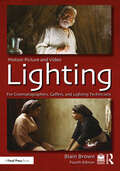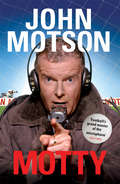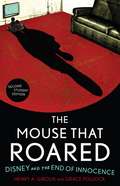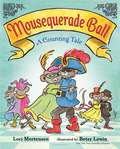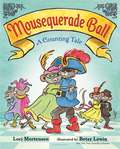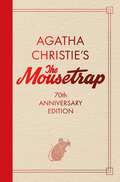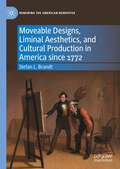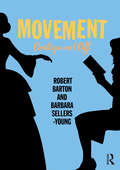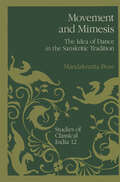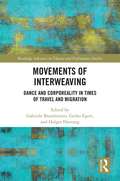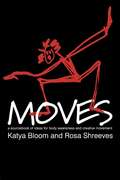- Table View
- List View
Motion Illustration: How to Use Animation Techniques to Make Illustrations Move
by Adam OsgoodMotion Illustration is a broad introduction to the emerging world of moving illustrations, written specifically for those coming from an illustration background. Bridging together illustration and animation disciplines in a new way, Adam Osgood shows that producing motion illustrations is achievable for anyone. Whether you're generating content for social media, designing GIFs, or creating fully animated videos, this book contains the tools and information you need to take your illustrated work to the next level and reach your audience in a new way. With tons of contemporary examples, sample exercises, and supporting online resources, this is perfect for illustrators wanting to make the jump to moving image. - How motion illustration fits in the context of animation and motion graphics, and how movement can help bring your images to life - Which tools and software are best to use depending on your desired outcomes - How illustrators animate with color, texture, composition, and effects to support narratives and ideas - Conversations with international professionals working across all media forms and with a wide variety of clients and subjects
Motion Picture and Video Lighting
by Blain BrownLighting is at the heart of filmmaking. The image, the mood, and the visual impact of a film are, to a great extent, determined by the skill and sensitivity of the director of photography in using lighting. Motion Picture and Video Lighting explores technical, aesthetic, and practical aspects of lighting for film and video. It covers not only how to light, but also why. This revised edition of Motion Picture and Video Lighting is the indispensable guide to film and video lighting. Written by an experienced professional, this comprehensive book explores light and color theory, equipment, and techniques to make every scene look its best, and is heavily illustrated throughout. Three new chapters discuss best practices of using light to benefit your film, and an extensive appendix includes discussion on additional tips and tricks. In addition, a robust companion website includes up-to-date video tutorials and other resources for students and professionals alike. Three new chapters: Scene Lighting Lighting as Storytelling Controlling Light Topics include: Lighting sources The lighting process Lighting basics LED, tungsten, Kino-Flo, HMI, and plasma lights Methods of controlling light Planning your lighting The basic methods: a lighting playbook Visual storytelling with light Understanding and controlling color Terminology Electricity and distribution Gripology Set operations The team: DP, gaffer, grips, lighting technicians Technical issues Lighting for greenscreen/bluescreen Typical equipment orders for large and small jobs Lighting for high speed and macro photography Lighting plans for small, medium, and large films
Motion Picture and Video Lighting
by Blain BrownLighting is at the heart of filmmaking. The image, the mood, and the visual impact of a film are, to a great extent, determined by the skill and sensitivity of the director of photography in using lighting. Motion Picture and Video Lighting explores technical, aesthetic, and practical aspects of lighting for film and video. It covers not only how to light, but also why. This revised edition of Motion Picture and Video Lighting is the indispensable guide to film and video lighting. Written by an experienced professional, this comprehensive book explores light and color theory, equipment, and techniques to make every scene look its best, and is heavily illustrated throughout. Three new chapters discuss best practices of using light to benefit your film, and an extensive appendix includes discussion on additional tips and tricks. In addition, a robust companion website includes up-to-date video tutorials and other resources for students and professionals alike. Three new chapters: Scene Lighting Lighting as Storytelling Controlling Light Topics include: Lighting sources The lighting process Lighting basics LED, tungsten, Kino-Flo, HMI, and plasma lights Methods of controlling light Planning your lighting The basic methods: a lighting playbook Visual storytelling with light Understanding and controlling color Terminology Electricity and distribution Gripology Set operations The team: DP, gaffer, grips, lighting technicians Technical issues Lighting for greenscreen/bluescreen Typical equipment orders for large and small jobs Lighting for high speed and macro photography Lighting plans for small, medium, and large films
Motion Picture and Video Lighting
by Blain BrownThis fully revised and updated fourth edition of Motion Picture and Video Lighting explores the technical, aesthetic, and practical aspects of lighting for film and video. It covers not only how to light, but also why. The process of lighting is emphasized, as well as practical techniques and visual storytelling with light. Written by experienced filmmaker, film school teacher, and author Blain Brown, this book emphasizes how the image, the mood, and the visual impact of a film are, to a great extent, determined by the skill and sensitivity of the director of photography in using lighting. It provides an indispensable, highly illustrated, and comprehensive guide to making every scene look its best. This new edition has been expanded to provide further guidance at the introductory level for students, those just starting their careers, and people already working in the business who want to move up. Topics include: Lighting Sources LEDs The Lighting Process Lighting Basics Controlling Light Lighting Scenes A Lighting Playbook Storytelling With Light Electricity and Distribution Gripology Set Operations Technical Issues A robust accompanying companion website also includes video tutorials and other resources for students and professionals alike, including lighting demonstrations, basic methods of lighting, using diffusion, color control, and other topics.
Motion Picture and Video Lighting
by Blain BrownThis fully revised and updated fourth edition of Motion Picture and Video Lighting explores the technical, aesthetic, and practical aspects of lighting for film and video. It covers not only how to light, but also why. The process of lighting is emphasized, as well as practical techniques and visual storytelling with light. Written by experienced filmmaker, film school teacher, and author Blain Brown, this book emphasizes how the image, the mood, and the visual impact of a film are, to a great extent, determined by the skill and sensitivity of the director of photography in using lighting. It provides an indispensable, highly illustrated, and comprehensive guide to making every scene look its best. This new edition has been expanded to provide further guidance at the introductory level for students, those just starting their careers, and people already working in the business who want to move up. Topics include: Lighting Sources LEDs The Lighting Process Lighting Basics Controlling Light Lighting Scenes A Lighting Playbook Storytelling With Light Electricity and Distribution Gripology Set Operations Technical Issues A robust accompanying companion website also includes video tutorials and other resources for students and professionals alike, including lighting demonstrations, basic methods of lighting, using diffusion, color control, and other topics.
Motty: Forty Years in the Commentary Box
by John MotsonFrom Ronnie Radford to Wayne Rooney, John Motson's knowledge and passion for football are unrivalled. In Motty, he shares his story for the first time and guides us through a career which has spanned forty years and over 2,000 matches. From reporting on the exploits of the giant-killing Hereford team in the 1972 FA Cup that made his name on Match of the Day, to the estimated twenty-million viewers who tuned in to his commentary on England's match with Portugal at the 2006 World Cup, Motson's time in the commentary box has delivered some unforgettable anecdotes. In dozens of fascinating behind-the-scenes stories, we hear about the greatest football matches he has watched and the greatest players and managers he has been privileged to know. Many of them are football icons; Bill Shankly, Alex Ferguson, Brian Clough, Alf Ramsey, and Matt Busby, amongst countless others.Motty is essential reading for anyone who has grown up with the undisputed voice of football.
The Mouse That Roared: Disney And The End Of Innocence ( PDF)
by Henry A. Giroux Grace PollockThis expanded and revised edition explores and updates the cultural politics of the Walt Disney Company and how its ever-expanding list of products, services, and media function as teaching machines that shape children's culture into a largely commercial endeavor. The Disney conglomerate remains an important case study for understanding both the widening influence of free-market fundamentalism in the new millennium and the ways in which messages of powerful corporations have been appropriated and increasingly resisted in global contexts. New in this edition is a discussion of Disney's shift in its marketing strategies towards targeting tweens and teens, as Disney promises to provide (via participation in consumer culture) the tools through which young people construct and support their identities, values, and knowledge of the world. The updated chapters from the highly acclaimed first edition are complimented with two new chapters, 'Globalizing the Disney Empire' and 'Disney, Militarization, and the National Security State After 9/11,' which extend the analysis of Disney's effects on young people to a consideration of the political and economic dimensions of Disney as a U.S.-based megacorporation, linking the importance of critical reception on an individual scale to a broader conception of democratic global community.
Mousequerade Ball: A Counting Tale
by Betsy Lewin Lori MortensenIn a castle on a hill, in a great grand hall,mice are getting ready for the Mousequerade Ball.They dress in their finest. What a grand affair!But when an unexpected guest arrives,the mice get quite a scare. Is the evening ruined? Should they run in fright? Or will a gallant mouse stand up and save the splendid night? Counting up to ten and back again, dancing all the while, this delightful story invites readers--and dancers--to the event of the season: the Mousequerade Ball!
Mousequerade Ball: A Counting Tale
by Betsy Lewin Lori MortensenIn a castle on a hill, in a great grand hall,mice are getting ready for the Mousequerade Ball.They dress in their finest. What a grand affair!But when an unexpected guest arrives,the mice get quite a scare. Is the evening ruined? Should they run in fright? Or will a gallant mouse stand up and save the splendid night? Counting up to ten and back again, dancing all the while, this delightful story invites readers--and dancers--to the event of the season: the Mousequerade Ball!
The Mousetrap: 70th Anniversary Edition
by Agatha Christie'Even more thrilling than the plot is the atmosphere of shuddering suspense . . . No one brews it better than Agatha Christie' Daily ExpressFor 70 years, Agatha Christie's The Mousetrap has kept millions of people, from every corner of the globe, on the edge of their seats, and it continues to be a sell-out hit of London theatre. This brand new edition of the world's longest-running play will contain a new introduction by Sophie Hannah, bestselling author of the authorised Agatha Christie Poirot continuation novels, as well as the official play script and a host of exclusive material from the show's archives. As news spreads of a murder in London, a group of seven strangers find themselves in a remote countryside guesthouse. When a police sergeant arrives, the guests discover - to their horror - that a killer is in their midst. One by one, the suspicious characters reveal their sordid pasts. Which one is the murderer? Who will be their next victim? And can you solve this world-famous mystery for yourself?This beautiful 70th anniversary edition will contain an introduction by Sophie Hannah, the official playscript, an exclusive interview with producer Adam Spiegel, a treasure trove of letters, speeches, photographs, and other fascinating insights into the making of this iconic play.
Moveable Designs, Liminal Aesthetics, and Cultural Production in America since 1772 (Renewing the American Narrative)
by Stefan L. BrandtThe book explores the liminal aesthetics of U.S. cultural and literary practice. Interrogating the notion of a presumptive unity of the American experience, Moveable Designs argues that inner conflict, divisiveness, and contradiction are integral to the nation’s cultural designs, themes, and motifs. The study suggests that U.S. literary and cultural practice is permeated by ‘moveable designs’—flexible, yet constant features of hegemonial practice that constitute an integral element of American national self-fashioning. The naturally pervasive liminality of U.S. cultural production is the key to understanding the resilience of American culture. Moveable Designs looks at artistic expressions across various media types (literature, paintings, film, television), seeking to illuminate critical phases of U.S. American literature and culture—from the revolutionary years to the movements of romanticism, realism, and modernism, up to the postmodern era. It combines a wide array of approaches, from cultural history and social anthropology to phenomenology. Connecting an analysis of literary and cultural texts with approaches from design theory, the book proposes a new way of understanding American culture as design. It is one of the unique characteristics of American culture that it creates—or, rather, designs—potency out of its inner conflicts and apparent disunities. That which we describe as an identifiable ‘American identity’ is actually the product of highly vulnerable, alternating processes of dissolution and self-affirmation.
Moved by Machines: Performance Metaphors and Philosophy of Technology (Routledge Studies in Contemporary Philosophy)
by Mark CoeckelberghGiven the rapid development of new technologies such as smart devices, robots, and artificial intelligence and their impact on the lives of people and on society, it is important and urgent to construct conceptual frameworks that help us to understand and evaluate them. Benefiting from tendencies towards a performative turn in the humanities and social sciences, drawing on thinking about the performing arts, and responding to gaps in contemporary artefact-oriented philosophy of technology, this book moves thinking about technology forward by using performance as a metaphor to understand and evaluate what we do with technology and what technology does with us. Focusing on the themes of knowledge/experience, agency, and power, and discussing some pertinent ethical issues such as deception, the narrative of the book moves through a number of performance practices: dance, theatre, music, stage magic, and (perhaps surprisingly) philosophy. These are used as sources for metaphors to think about technology—in particular contemporary devices and machines—and as interfaces to bring in various theories that are not usually employed in philosophy of technology. The result is a sequence of gestures and movements towards a performance-oriented conceptual framework for a thinking about technology which, liberated from the static, vision-centred, and dualistic metaphors offered by traditional philosophy, can do more justice to the phenomenology of our daily embodied, social, kinetic, temporal, and narrative performances with technology, our technoperformances. This book will appeal to scholars of philosophy of technology and performance studies who are interested in reconceptualizing the roles and impact of modern technology.
Moved by Machines: Performance Metaphors and Philosophy of Technology (Routledge Studies in Contemporary Philosophy)
by Mark CoeckelberghGiven the rapid development of new technologies such as smart devices, robots, and artificial intelligence and their impact on the lives of people and on society, it is important and urgent to construct conceptual frameworks that help us to understand and evaluate them. Benefiting from tendencies towards a performative turn in the humanities and social sciences, drawing on thinking about the performing arts, and responding to gaps in contemporary artefact-oriented philosophy of technology, this book moves thinking about technology forward by using performance as a metaphor to understand and evaluate what we do with technology and what technology does with us. Focusing on the themes of knowledge/experience, agency, and power, and discussing some pertinent ethical issues such as deception, the narrative of the book moves through a number of performance practices: dance, theatre, music, stage magic, and (perhaps surprisingly) philosophy. These are used as sources for metaphors to think about technology—in particular contemporary devices and machines—and as interfaces to bring in various theories that are not usually employed in philosophy of technology. The result is a sequence of gestures and movements towards a performance-oriented conceptual framework for a thinking about technology which, liberated from the static, vision-centred, and dualistic metaphors offered by traditional philosophy, can do more justice to the phenomenology of our daily embodied, social, kinetic, temporal, and narrative performances with technology, our technoperformances. This book will appeal to scholars of philosophy of technology and performance studies who are interested in reconceptualizing the roles and impact of modern technology.
Movement: Onstage and Off
by Robert Barton Barbara Sellers-YoungMovement: Onstage and Off is the complete guide for actors to the most effective techniques for developing a fully expressive body. It is a comprehensive compilation of established fundamentals, a handbook for movement centered personal growth and a guide to helping actors and teachers make informed decisions for advanced study. This book includes: fundamental healing/conditioning processes essential techniques required for versatile performance specialized skills various training approaches and ways to frame the actor’s movement training. Using imitation exercises to sharpen awareness, accessible language and adaptable material for solo and group work, the authors aim to empower actors of all levels to unleash their extraordinary potential.
Movement: Onstage and Off
by Robert Barton Barbara Sellers-YoungMovement: Onstage and Off is the complete guide for actors to the most effective techniques for developing a fully expressive body. It is a comprehensive compilation of established fundamentals, a handbook for movement centered personal growth and a guide to helping actors and teachers make informed decisions for advanced study. This book includes: fundamental healing/conditioning processes essential techniques required for versatile performance specialized skills various training approaches and ways to frame the actor’s movement training. Using imitation exercises to sharpen awareness, accessible language and adaptable material for solo and group work, the authors aim to empower actors of all levels to unleash their extraordinary potential.
Movement and Mimesis: The Idea of Dance in the Sanskritic Tradition (Studies of Classical India #12)
by Mandakranta BoseThe most comprehensive view of the evolution of dancing in India is one that is derived from Sanskrit textual sources. These texts are the basic material that students of the dance in India must examine in order to uncover its past. Since the rebirth of informed interest in dancing in early twentieth century, its antiquity has been acknowledged but precisely what the art was in antiquity remains unclear. Discovering the oldest forms of dancing in India requires, as do other historical quests, a reconstruction of the past and, again as in other historical investigations, the primary sources of knowledge are records from the past. In this case the records are treatises and manuals in Sanskrit that discuss and describe dancing. These are the sources that the present work sets out to mine. These texts taken collectively are more than records of a particular state of the art. They testify to the growth of the theory and practice of the art and thus establish it as an evolving rather than a fixed art form that changed as much in response to its own expanding aesthetic boundaries as to parallel or complementary forms of dance, drama and music that impinged upon it as India's social and political situation changed. When we place the Sanskrit treatises in chronological sequence it becomes clear that the understanding of the art has changed through time, in its infancy as well as in maturer periods.
Movement as Meaning in Experimental Cinema: The Musical Poetry of Motion Pictures Revisited
by Daniel BarnettMovement as Meaning in Experimental Cinema offers sweeping and cogent arguments as to why analytic philosophers should take experimental cinema seriously as a medium for illuminating mechanisms of meaning in language. Using the analogy of the movie projector, Barnett deconstructs all communication acts into functions of interval, repetition and context. He describes how Wittgenstein's concepts of family resemblance and language games provide a dynamic perspective on the analysis of acts of reference. He then develops a hyper-simplified formula of movement as meaning to discuss, with true equivalence, the process of reference as it occurs in natural language, technical language, poetic language, painting, photography, music, and of course, cinema. Barnett then applies his analytic technique to an original perspective on cine-poetics based on Paul Valery's concept of omnivalence, and to a projection of how this style of analysis, derived from analog cinema, can help us clarify our view of the digital mediasphere and its relation to consciousness. Informed by the philosophy of Quine, Dennett, Merleau-Ponty as well as the later work of Wittgenstein, among others, he uses the film work of Stan Brakhage, Tony Conrad, A.K. Dewdney, Nathaniel Dorsky, Ken Jacobs, Owen Land, Saul Levine, Gregory Markopoulos Michael Snow, and the poetry of Basho, John Cage, John Cayley and Paul Valery to illustrate the power of his unique perspective on meaning.
Movement as Meaning in Experimental Cinema: The Musical Poetry of Motion Pictures Revisited
by Daniel BarnettMovement as Meaning in Experimental Cinema offers sweeping and cogent arguments as to why analytic philosophers should take experimental cinema seriously as a medium for illuminating mechanisms of meaning in language. Using the analogy of the movie projector, Barnett deconstructs all communication acts into functions of interval, repetition and context. He describes how Wittgenstein's concepts of family resemblance and language games provide a dynamic perspective on the analysis of acts of reference. He then develops a hyper-simplified formula of movement as meaning to discuss, with true equivalence, the process of reference as it occurs in natural language, technical language, poetic language, painting, photography, music, and of course, cinema. Barnett then applies his analytic technique to an original perspective on cine-poetics based on Paul Valery's concept of omnivalence, and to a projection of how this style of analysis, derived from analog cinema, can help us clarify our view of the digital mediasphere and its relation to consciousness. Informed by the philosophy of Quine, Dennett, Merleau-Ponty as well as the later work of Wittgenstein, among others, he uses the film work of Stan Brakhage, Tony Conrad, A.K. Dewdney, Nathaniel Dorsky, Ken Jacobs, Owen Land, Saul Levine, Gregory Markopoulos Michael Snow, and the poetry of Basho, John Cage, John Cayley and Paul Valery to illustrate the power of his unique perspective on meaning.
Movement Directors in Contemporary Theatre: Conversations on Craft (Theatre Makers)
by Ayse Tashkiran'When directors understand the value of a movement director they remove any sense of hierarchy within the room and place movement directors firmly by their side for they are and should be their co-pilot, navigating and creating the world of the play.'- Joan Iyiola Movement directors work with the physical, living bodies at the heart of theatre productions, creating movement languages with actors and directors. Through a series of in-depth interviews with leading theatre practitioners, Ayse Tashkiran charts the growth of the movement director in contemporary theatre. The voices of Jane Gibson, Sue Lefton, Kate Flatt, Toby Sedgwick, Siân Williams, Struan Leslie, Ellen Kane, Peter Darling, Steven Hoggett, Ann Yee, Imogen Knight and Shelley Maxwell explore processes of creativity, collaboration and innovation for the moving body in performance. The conversations open up: Growth of movement direction through the 20th century New insights into embodied theatre practice Diverse movement approaches and creative preparation Physical trainings and influences Working methods with directors and actors in the rehearsal room Movement for actors in opera, film, television and musical theatre Relationships between movement direction and theatre choreography Potential future developments in the field
Movement Directors in Contemporary Theatre: Conversations on Craft (Theatre Makers)
by Ayse Tashkiran'When directors understand the value of a movement director they remove any sense of hierarchy within the room and place movement directors firmly by their side for they are and should be their co-pilot, navigating and creating the world of the play.'- Joan Iyiola Movement directors work with the physical, living bodies at the heart of theatre productions, creating movement languages with actors and directors. Through a series of in-depth interviews with leading theatre practitioners, Ayse Tashkiran charts the growth of the movement director in contemporary theatre. The voices of Jane Gibson, Sue Lefton, Kate Flatt, Toby Sedgwick, Siân Williams, Struan Leslie, Ellen Kane, Peter Darling, Steven Hoggett, Ann Yee, Imogen Knight and Shelley Maxwell explore processes of creativity, collaboration and innovation for the moving body in performance. The conversations open up: Growth of movement direction through the 20th century New insights into embodied theatre practice Diverse movement approaches and creative preparation Physical trainings and influences Working methods with directors and actors in the rehearsal room Movement for actors in opera, film, television and musical theatre Relationships between movement direction and theatre choreography Potential future developments in the field
Movement Training for Actors (Performance Books)
by Jackie Snow"This book vividly captures vital and imaginative lessons from one of the most influential and joyous traditions of contemporary actor training. Any actor or teacher, who is devoted to the transformational power of the theatre, will want to return to these pages again and again, finding in them not only the work to be done, but also the inspiration to do it."James Bundy - Dean, Yale School of Drama; Artistic Director, Yale Repertory TheatreMovement training techniques allow actors to acquire the physical body language and non-verbal skills to clearly express the ideas and emotions of their characters. The techniques contained in this book help actors to develop awareness of their own natural posture, walk and rhythm, release the physical imagination and transform into the characters they are portraying, on stage, in film or on television.Movement Training for Actors provides a practical workbook approach to the core fundamentals of movement, fusing together the work of the key practitioners: Sigurd Leeder, Kurt Jooss, Rudolf Laban, Trish Arnold, Litz Pisk, F. M. Alexander, Moshé Feldenkrais, Jerzy Growtowski, Jacques Lecoq and Belinda Quirey. Chapters include Games, Pure Movement, Historical Dance, Acrobatics and Animal Study. The book is illustrated with photographs throughout and contains a DVD featuring over an hour of movement exercises further demonstrating the techniques. Movement Training for Actors is a masterclass on movement written by experienced coach, Jackie Snow and a culmination of her many years of teaching and coaching professionals. The highly practical approach will suit actors of all abilities as well as serving as an inspirational teaching guide.
Movements of Interweaving: Dance and Corporeality in Times of Travel and Migration (Routledge Advances in Theatre & Performance Studies)
by Gabriele Brandstetter Gerko Egert Holger HartungMovements of Interweaving is a rich collection of essays exploring the concept of interweaving performance cultures in the realms of movement, dance, and corporeality. Focusing on dance performances as well as on scenarios of cultural movements on a global scale, it not only challenges the concept of intercultural dance performances, but through its innovative approach also calls attention to the specific qualities of "interweaving" as a form of movement itself. Divided into four sections, this volume features an international team of scholars together developing a new critical perspective on the cultural practices of movement, travel and migration in and beyond dance.
Movements of Interweaving: Dance and Corporeality in Times of Travel and Migration (Routledge Advances in Theatre & Performance Studies)
by Gabriele Brandstetter Gerko Egert Holger HartungMovements of Interweaving is a rich collection of essays exploring the concept of interweaving performance cultures in the realms of movement, dance, and corporeality. Focusing on dance performances as well as on scenarios of cultural movements on a global scale, it not only challenges the concept of intercultural dance performances, but through its innovative approach also calls attention to the specific qualities of "interweaving" as a form of movement itself. Divided into four sections, this volume features an international team of scholars together developing a new critical perspective on the cultural practices of movement, travel and migration in and beyond dance.
Moves: A Sourcebook of Ideas for Body Awareness and Creative Movement
by Katya Bloom Rosa ShreevesFirst Published in 1998. Routledge is an imprint of Taylor & Francis, an informa company.
Moves: A Sourcebook of Ideas for Body Awareness and Creative Movement
by Katya Bloom Rosa ShreevesFirst Published in 1998. Routledge is an imprint of Taylor & Francis, an informa company.


